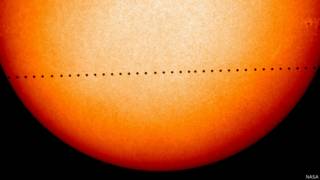 Image copyright NASA
Image copyright NASA
The “bite” or “transit” Mercury occurs only a dozen times each century, at intervals of 3, 7, 10 and 13 years.
happens when the Sun, Mercury and Earth are perfectly aligned , and because both planets orbit in the same plane.
and this Monday, May 9 it will be one of those rare occasions when you can see the planet as a black dot on the solar surface .
the phenomenon takes place between 11:12 and . 18:42 UTC
the transits of the sun can be made only Mercury and Venus, being the only two planets in orbits interior; that is, closer to the sun than our planet.
The last time Mercury transited on the Sun was the November 8, 2006 and the next will be on November 11, 2019, but then will have to wait until November 13, 2032.
And Venus do with even less frequently, just twice a century.
Both phenomena have been studied since the seventeenth century by scientists such as Pierre Gassendi, Jeremiah Horrocks, Edmond Halley and Mikhail Lomonosov.
The comments have been important in determining the actual size of the planets, specifies the distance from these bodies and the Sun, and to establish how the atmosphere of Venus.
Warning
As the diameter of Mercury is only 1/158 the diameter of the solar disc, to see the traffic you need to use a telescope equipped with a special filter – a diaphragm very dense glass or plastic called polyethylene terephthalate, Mylar or PET remove dangerous radiation for the view .
the phenomenon “can not observe dark glasses, negatives, X-rays, smoked glass, colored plastics, CDs or CD, glass solder “, or other materials, says astronomer Germán Puerta Restrepo in his blog of the Cultural Deputy Manager of the Bank of the Republic of Colombia.
And that do so can cause serious eye injury .
However, there is a way to enjoy it even without a telescope at home or be a member of an astronomy club.
and how did French philosopher and astronomer Pierre Gassedi in 1631 , when witnessed first step of a planet to a star, gives us clues how.
Gassedi managed to see Mercury on the solar disk through a camera obscura or pinhole .
Although his was of large scale needed a telescope, a darkroom and an assistant at him, several experts explain the steps for making a homemade camera obscura .
Materials
According Lech Mankiewicz, the Center for Theoretical Physics of the Polish Academy of Sciences and Pawel Rudawy the Astronomical Institute of the University of Wroclaw, both in Poland these materials are needed:
- A cardboard tube with caps, such as those used to store posters, the longer the better
- Two black cardboard A4
- A piece of vellum or tracing paper
- A cardboard envelope
- A fine needle
- Scissors and a paper cutter
- Glue and tape
Manufacturing
experts forward you have to be very careful and be patient.
First of all caps to the tube to be removed.
it should cut a circle diameter of black cardboard lids, cover the inside of one with this and strengthen the bond with tape. Make sure that it is securely covered .
Then, using the pin, to do a fine hole in the center that spans both the card and the cover.
The hole should have a diameter of 0.5 millimeters and a millimeter.
cap lined with cardboard at one end is placed tube, and the other cover is made a hole in the center, about two-thirds of its diameter.
in this case, the hole will be covered with greaseproof paper and also sealed with tape.
After placing the cap on the other end of the tube, home darkroom is almost complete.
But before pointing it skyward, must be met two imprescincibles to protect the eyes of the Sun steps.
this will have to cut the cardboard envelope a circle with a diameter slightly less than the diameter of the pipe and remove it.
in that hole is then inserted the cardboard tube.
the wrapper should be near the top was covered with greaseproof paper and not in the center of the tube.
So, when you point the tube in the sun, the envelope completely cover the face, leaving the shade. This step is very important, experts warn .
For more protection against radiation, the tube with the rest of the black card will be covered.
Once done all this, just be pointing the tube to the Sun, with the end in which the pinhole is made.
so, what will look the other end is the image of Mercury on the solar disk projected on a surface- the green wall paper and securely.
the Argentine Institute for Radio Astronomy offers an alternative on its website, which includes a cardboard box.
But if you do not want to take this job, you can always consult directly through the computer screen, because NASA will issue here.
No comments:
Post a Comment